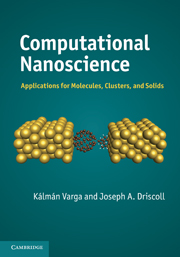Book contents
- Frontmatter
- Contents
- Preface
- Part I One-dimensional problems
- Part II Two- and three-dimensional systems
- 7 Three-dimensional real-space approach: from quantum dots to Bose–Einstein condensates
- 8 Variational calculations in two dimensions: quantum dots
- 9 Variational calculations in three dimensions: atoms and molecules
- 10 Monte Carlo calculations
- 11 Molecular dynamics simulations
- 12 Tight-binding approach to electronic structure calculations
- 13 Plane wave density functional calculations
- 14 Density functional calculations with atomic orbitals
- 15 Real-space density functional calculations
- 16 Time-dependent density functional calculations
- 17 Scattering and transport in nanostructures
- 18 Numerical linear algebra
- Appendix: Code descriptions
- References
- Index
14 - Density functional calculations with atomic orbitals
from Part II - Two- and three-dimensional systems
Published online by Cambridge University Press: 05 June 2012
- Frontmatter
- Contents
- Preface
- Part I One-dimensional problems
- Part II Two- and three-dimensional systems
- 7 Three-dimensional real-space approach: from quantum dots to Bose–Einstein condensates
- 8 Variational calculations in two dimensions: quantum dots
- 9 Variational calculations in three dimensions: atoms and molecules
- 10 Monte Carlo calculations
- 11 Molecular dynamics simulations
- 12 Tight-binding approach to electronic structure calculations
- 13 Plane wave density functional calculations
- 14 Density functional calculations with atomic orbitals
- 15 Real-space density functional calculations
- 16 Time-dependent density functional calculations
- 17 Scattering and transport in nanostructures
- 18 Numerical linear algebra
- Appendix: Code descriptions
- References
- Index
Summary
Atomic orbitals
Besides plane waves and real-space grids, atomic orbitals [59, 332, 158, 133, 258, 319] are also a popular choice as basis states in electronic structure calculations. Each choice of basis states has its own advantages and disadvantages. The most important advantages of plane waves and real space grids are their straightforward formalism and simple control of accuracy (an energy cutoff and a grid spacing, respectively). However, methods based on the linear combination of atomic orbitals (LCAO) are more efficient in terms of basis size, because atomic orbitals are much better suited to represent molecular or Bloch wave functions. Another advantage of localized atomic orbitals is that the Hamiltonian matrix becomes sparse as the system size increases. This has recently renewed interest in LCAO bases because the sparsity makes them suitable for order-N methods [246, 215, 200, 104], in which computational effort scales linearly with system size. Local-atomic-orbital bases also offer a natural way of quantifying the magnitudes of atomic charge, orbital population, bond charge, charge transfer, etc.
The disadvantages of LCAO include the facts that (i) the functions can become overcomplete (linear dependence can occur in a calculation if two similar functions are centered at the same atom), (ii) they are difficult to program (especially if high-angular-momentum functions are needed), and (iii) it is difficult to test or demonstrate absolute convergence since there are many more parameters than the energy cutoff of the plane wave approach.
- Type
- Chapter
- Information
- Computational NanoscienceApplications for Molecules, Clusters, and Solids, pp. 317 - 331Publisher: Cambridge University PressPrint publication year: 2011



